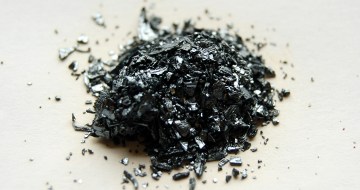
Iodine
Iodine General
| Name:Iodine | Symbol:I |
| Type:Halogen | Atomic weight:126.9045 |
| Density @ 293 K:4.93 g/cm3 | Atomic volume: 25.74 cm3/mol |
|
Discovered:
Iodine was discovered by Bernard Courtois in 1811. He isolated the element by adding sulfuric acid to seaweed ashes. This produced a purple vapor, which condensed to form dark crystals of iodine. Its name comes from the Greek work 'iodes', meaning violet. |
|
Iodine States
| State (s, l, g):solid | |
| Melting point:386.6 K (113.5 °C) | Boiling point:457 K (184 °C) |
Iodine Energies
| Specific heat capacity:0.214 J g-1 K-1 | Heat of atomization:107 kJ mol-1 |
| Heat of fusion: 15.52 kJ mol-1 of I2 | Heat of vaporization : 41.57 kJ mol-1 of I2 |
| 1st ionization energy:1008.4 kJ mol-1 | 2nd ionization energy:1845.8 kJ mol-1 |
| 3rd ionization energy:3184 kJ mol-1 | Electron affinity: 295.16 kJ mol-1 |
Iodine Oxidation & Electrons
| Shells:2,8,18,18,7 | Electron configuration:[Kr] 4d10 5s2 5p5 |
| Minimum oxidation number:-1 | Maximum oxidation number:7 |
| Min. common oxidation no.:0 | Max. common oxidation no.:7 |
| Electronegativity (Pauling Scale):2.66 | Polarizability volume:5 Å3 |
Iodine Appearance & Characteristics
| Structure:layers of I2 | Color:bluish-black |
| Hardness:mohs | |
|
Harmful effects:
In small doses, iodine is slightly toxic and it is highly poisonous in large amounts. Elemental iodine is an irritant which can cause sores on the skin. Iodine vapor causes extreme eye irritation. |
|
|
Characteristics:
Iodine is a bluish-black, lustrous solid. Although it is less reactive than the elements above it in group 17 (fluorine, chlorine and bromine) it still forms compounds with many other elements. Uses: Iodine is important in medicine, in both radioactive and non-radioactive forms. Iodide and thyroxin, which contains iodine, are used inside the body. |
|
Iodine Reactions
| Reaction with air:none | Reaction with 6 M HCl:none |
| Reaction with 15 M HNO3:mild, ⇒ HIO3 | Reaction with 6 M NaOH:mild, ⇒ OI-, I- |
Iodine Compounds
| Oxide(s):I2O5, I4O9, I2O4 | Chloride(s):ICl, ICl3 |
| Hydride(s): HI |
Iodine Radius
| Atomic radius:140 pm | Ionic radius (1+ ion):pm |
| Ionic radius (2+ ion):pm | Ionic radius (3+ ion):pm |
| Ionic radius (2- ion):pm | Ionic radius (1- ion): 206 pm |
Iodine Conductivity
| Thermal conductivity:0.45 W m-1 K-1 | Electrical conductivity:1.0 x 10-7 S cm-1 |
Iodine Abundance & Isotopes
| Abundance earth's crust:450 parts per billion by weight, 73 parts per billion by moles | |
| Abundance solar system:parts per billion by weight, parts per billion by moles | |
| Cost, pure:$8.3 per 100g | |
| Cost, bulk:$ per 100g | |
|
Source:
In nature, iodine occurs in the form of iodide ions, mainly in seawater. It is introduced into the food chain via seaweed and other sea-plants. Iodine is found in some minerals and soils. Commercially, iodine is obtained in several ways, such as taking iodine vapour from processed brine, by ion exchange of brine or by releasing iodine from iodate taken from nitrate ores. |
|
|
Isotopes:
34 whose half-lives are known, with mass numbers 108 to 141. Of these, only one is stable: 127I |
|
Iodine Other
|
Other:
|
|
Prev: Tellurium Next: Xenon |